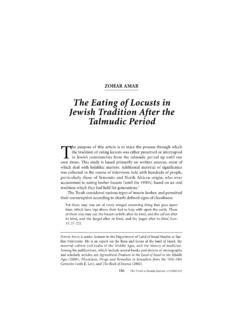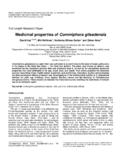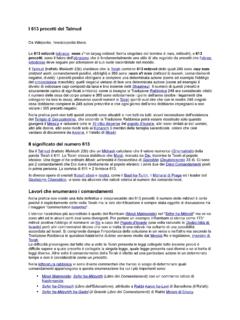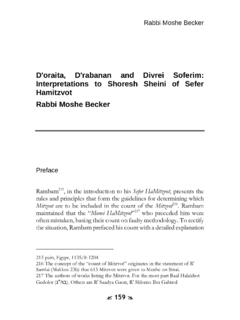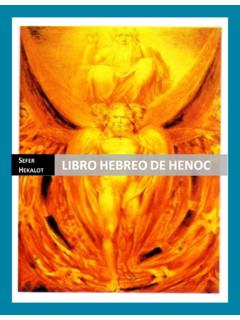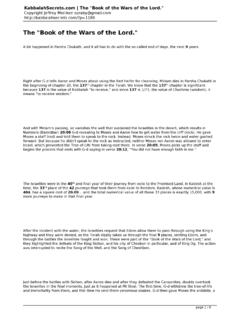Transcription of What’s the Truth about … Har HaBayit?
1 MISCONCEPTION:Many religiousJews do not visit Har habayit (theTemple Mount) today. This is becausewe are all presumed to be in a state oftumat met(ritual impurity due to con-tact with the dead), and a tamei met isprohibited from ascending HarHaBayit. (Since the removal of tumatmetrequires the use of the ashes of aparah adumah,which are currently notavailable, every Jew is presumed to bein this state of impurity.)FACT:Although individuals with cer-tain forms of ritual impurities arebarred from all of Har habayit , a tameimetmay enter the peripheral areas ofHar habayit surrounding the centralholier region that included the Templecompound. Thus, although we cur-rently lack the means to remove tumatmet,this is not really a deterrent for as-cending Har habayit .
2 Those who re-frain from ascending do so because ofother halachic or political concerns orbecause of archeological :Halachah recognizesdifferent levels of kedushah (holiness)that relate to both time and , Shabbat has more kedushahthanyom tov, which in turn has more ke-dushah than chol is re-flected, for example, in variousdifferences among the holy days withregard to Havdalah texts and the num-ber of aliyotin the Torah reading, aswell as in the range of prohibited activ-ities and the punishments associatedwith their violation. A similar hierar-chy is relevant to the sanctity pertain-ing to space. The Mishnah (Keilim1:6-9), for example, delineates ten levelsof spatial kedushah within the Land ofIsrael, which is holier than all otherlands.
3 The first three levels are the fol-lowing: walled cities in Israel, whichare holier than the rest of the Land;Jerusalem, which is holier than otherwalled cities; and the Temple Mount,which is holier than Jerusalem. The re-maining seven levels are areas of in-creasing sanctity within the Templeprecinct. The level of sanctity of anarea is reflected in the kinds of mitzvotthat may be performed there as well asin the laws regarding sanctified areas in Jerusalemcorrespond to the Israelite desert en-campment (Tosefta, Keilim1:10; Sifri,Naso11; Rambam, Beit Habechirah7:11;see Aruch Hashulchan Ha atid, BeitHamikdash 14:17, 36:7). Three concen-tric levels of sanctity existed in the en-campment: the innermost area calledMachaneh Shechinah, the Divine Campthat contained the mishkan (Taberna-cle); Machaneh Leviyah,the encamp-ment of the Levites that surroundedMachaneh Shechinah,and MachanehYisrael, an area beyond MachanehLeviyahwhere the rest of the Jews en-camped.
4 When the Jews settled theLand of Israel these camps were rep-resented by the following sanctifiedareas: the Azarah (Temple Courtyard),which started at Sha ar Nikanor(theNikanor Gate) and included the BeitHamikdashbuilding and the altar(Machaneh Shechinah); Har habayit (Machaneh Leviyah) and the rest ofJerusalem (Machaneh Yisrael).The verses in Bamidbar 5:2-4 thatdescribe the laws pertaining to thedesert encampment would seem to in-dicate that individuals with all types oftumah(ritual impurity) were removedfrom all three camps. However, Chazalexplain (Sifri, Naso: 4; Pesachim67a-68a; Rambam, Biat Mikdash3:1-2) thespecific rules:At one extreme, a metzorah (onewho is afflicted with tzara at) is ex-cluded from Machaneh Yisrael; thus,he is not permitted anywhere inJerusalem.
5 At the other extreme, atamei metis barred from MachanehShechinahbut is permitted withinMachaneh Chazal derive this(Tosefta, Keilim1:7; Pesachim67a;Sotah20b) from the fact that a corpseitself was brought into MachanehLeviyahwhen Moshe, a Levite, trans-ported Joseph s bones from Egypt forburial in the Land of Israel (see She-mot 13:19; Nazir45a; Rambam, BeitHabechirah7:15 andBiat Mikdash3:4).Thus, according to Biblical law, atamei metmay ascend Har HaBayitand proceed all the way up to theAzarah, untilSha ar ACTION Summer 5769/2009 Legal-EaseBy Ari Z. ZivotofskyWhat s the Truth about ..Har HaBayit? Rabbi Dr. Ari Zivotofsky is on the faculty ofthe Brain Science Program at Bar-Ilan Uni-versity in :Layout 1 5/12/09 9:13 PM Page 58 Summer 5769/2009 JEWISH ACTION I59ever, the rabbis added additional restrictions, and decreedthat a tamei metmay not go all the way to the Azarahbutmust stop at the Cheil,3the same boundary that applied toa Biblical prohibition of entering theAzarah and the Temple building itself for a tamei met in-curs the severe punishment of karet(Bamidbar 19:13, 20;Makkot 14b; Rambam, Biat Mikdash3:12-13 and SeferHamitzvot, negative 77, positive 31).
6 There is, however, another form of tumahto which addi-tional restrictions apply, including the prohibition againstentering any part of Har habayit . This applies to an individ-ual in a state of tumah hayotzei megufo(an impurity thatemanates from his body), and includes niddah(menstrua-tion), yoledet(post-partum), zav, zavah5 (Rambam, BeitHabechirah 7:15 and Biat Mikdash 3:3; Pesachim67-68) and aba al keri(one who experienced a seminal emission). Whilea ba al keriis usually included in this list, and is the most rel-evant form of tumahwith regard to ascending Har HaBayitnowadays, the Mishnah(Keilim1:8) and Tosefta (Keilim1:7)both fail to mention the ba al keriwhen listing those forbid-den from ascending Har The inclusion of the ba alkeri, however, is an explicit statement of Rabbi Yochanan(Pesachim67b-68) and seems to be an explicit mishnah,asexplained by the Gemara (Tamid27b).
7 Strangely, when list-ing those prohibited from ascending Har habayit , Rambamtwice (Beit Habechirah7:15 and Biat Mikdash3:3) omitsmention of the ba al keri. Addressing this omission, theMishnah Lemelech(Beit Habechirah7:15; cf. Mishnah Lem-elech, Biat Hamikdash3:3) says Rambam maintains that theba al keriis, in fact, included and notes that the ba al keri sinclusion in the prohibition is implicit in the Rambam intwo other places (Beit Habechirah 8:7 and his textual sourcein Biat Mikdash3:87). Alternatively, it is possible that Ram-TEMPLE MOUNT500 X 500 AMOTSANCTUARYBUILDINGTEMPLECOURTYARD(Aza rah)WOMEN SCOURTYARD(Ezrat Nashim)NIKANOR GATE(Sha ar Nikanor)SOREGCHEILA dapted from the ArtScroll Yad Avraham Mishnah Series,with per-mission from ArtScroll/Mesorah Publications, :Layout 1 5/12/09 9:13 PM Page 5960 IJEWISH ACTION Summer 5769/2009bam maintains that the ba al keriis in-deed permitted on the peripheral areasof Har habayit (see Aruch HashulchanHa atid; Biat Mikdash36:10).
8 8A person experiencing one of thesestates oftumah who ascends HarHaBayit does not incur the penalty ofkaret but is guilty of violating a nega-tive prohibition, for which he shouldreceive lashes (Rambam, Biat Mikdash3:8). In order to remove these types oftumah, one must wait a requisite pe-riod of time, immerse in a mikvah andwait for the sun to the pe-riod between immersion and sunsetthe individual has the status of a tvulyom,and is permitted on Har HaBayitbut can go no further than the EzratNashim (Women s Courtyard) (Ram-bam, Biat Mikdash 3:5-6 and BeitHabechirah7:17).10In summary, the generally acceptedhalachot are as follows: a tamei metmayascend Har habayit , but may only pro-ceed as far as the in a stateof tumah hayotzei megufoare barredfrom the entire Har habayit ; once sucha person becomes a tvul yom, he is per-mitted on most of Har of the above regulations were ineffect during the time of the question is, Are they applicabletoday?
9 This depends on whether thearea where the Temple stood retainedits sanctity despite the destruction ofthe Beit Hamikdash,11which is a subjectof debate among halachic (Beit Habechirah6:14-15) andmany other Rishonim12andAcharonim13maintain that the sanctityof the Temple persists, and thus just asone may theoretically offer sacrificesthere today, were a tamei met to enterthe area of the mikdash, he would stillincur the punishment of karet. Thesesources assert that the initial sanctifi-cation of the area by King Solomon isin effect; he sanctified it for his timeand forever after. Rambam states: Even though the mikdash is todaydestroyed due to our sins, one is obli-gated in its reverence just as when it wasstanding. One should not enter exceptwhere he is permitted, and should not sitin the Azarahand not act with levity op-posite the Eastern Gate.
10 Even thoughit is destroyed it still possesses its holi-ness (Beit Habechirah 7:7).Opposing Rambam, Ra avad (BeitHabechirah6:14) opines that since theBeit Hamikdashwas destroyed, theoriginal sanctity of the area is no longerin effect and therefore the punishmentof karetno longer applies. Some under-stand Ra avad as disagreeing with Ram-bam only with respect to the actualpunishment of karet;according to thisreading, he concurs with Rambam inthat the restrictions pertaining to HarHaBayit still stand or at the very least,he is uncertain as to whether these re-strictions still apply and therefore doesnot permit entry ab are ofthe opinion that Ra avad permits freeentry to all of Har Today, Israel s Chief Rabbinate andmany rabbis forbid Jews from ascend-ing Har habayit , and thus no shul orother Jewish structure is found rabbis do permit entry (the num-ber of religious Jews who visit is in-creasing, but is still quite small).
